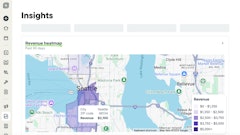
This season is about weathering a storm of rising costs and shrinking margins for midsized landscaping businesses. Fuel prices are volatile, labor is scarce and clients demand more for less. Fleet managers have to cut through a maze of operational hurdles. Despite these challenges, many lack access to industrywide insights, relying solely on internal data that offers an incomplete view of their operations.
These fleets miss opportunities to identify weaknesses, set achievable goals and make meaningful improvements without understanding how they compare to peers. This limited perspective stifles growth and hinders efforts to optimize costs, maximize vehicle utilization and improve driver safety—areas where enterprise fleets with greater resources often maintain a competitive edge.
But what if midsized fleets had a clear map? That's where benchmarking comes in; it's a process that transforms raw data into actionable insights that drive efficiency and growth. It's not just about comparing numbers; it's about transforming the fleet's data into the actionable insights needed to stay ahead in today's demanding industry.
The data divide: Why midsized fleets struggle without benchmarking
Many midsized fleets operate in a data vacuum, relying solely on internal performance metrics. While internal data provides a baseline, it lacks the broader industry context necessary for informed decision-making. Without benchmarking, these fleets risk setting unrealistic goals and missing opportunities for improvement. They will eventually fall behind competitors who leverage data-driven insights for smarter decision-making.
Benchmarking offers a structured methodology for comparing key performance indicators against industry peers. This allows fleet managers to identify strengths, weaknesses and opportunities for improvement. Rather than relying on siloed internal data, benchmarking provides a clear understanding of how a fleet's performance compares to industry standards. This enables managers to optimize operations across critical areas such as fuel efficiency, vehicle utilization, maintenance costs and safety metrics.
Root to rise: How benchmarking cultivates thriving landscaping businesses
Imagine your landscaping fleet as a finely tuned machine capable of peak performance and sustained growth, but how do you ensure it's running at its best? Benchmarking acts as an operational compass. For midsized landscaping fleets, often the backbone of the industry, this isn't just about numbers—it's about cultivating a thriving, resilient operation. By embracing a strategic approach to data analysis, fleet managers can transform raw information into actionable strategies, fueling a trajectory of consistent profitability and expansion.
Here are ways fleet leaders can dig deeper into the benefits of benchmarking and watch their business bloom:
- Compliance as a core strength: Proactive fleet data tracking empowers fleets to stay ahead of DOT regulations, from meticulous inspections to precise emissions monitoring and driver hour management. This builds a bedrock of trust and prevents costly legal headaches, ensuring fleets remain a reliable force.
- Eradicating downtime, nurturing uptime: Data-driven inspections as preventative care for fleet equipment. By identifying potential issues before they escalate, fleets can minimize costly emergency repairs and keep their crews on schedule, ensuring high client satisfaction.
- Predicting the future with trend forecasting: By analyzing trends, fleet managers can anticipate seasonal spikes, evaluate emerging technologies like electric or autonomous equipment and make smart, forward-thinking decisions about upgrades and expansion.
- Cultivating cost savings: Benchmarking illuminates areas for improvement, whether it's optimizing fuel consumption, streamlining maintenance or maximizing equipment utilization. Implementing efficient routing, reducing idle time and refining driver performance can drastically trim operating expenses.
- Elevating driver safety: Monitor driving behaviors to identify risks, such as speeding or aggressive braking. Implementing targeted training and corrective measures protects employees and the brand's reputation and fosters a culture of safety.
- Dominating the landscape: Benchmarking is the secret weapon in a market where efficiency and reliability reign supreme. While midsized businesses dominate the market, many struggle to maintain a competitive edge. By refining operations and optimizing resource allocation, fleet managers can confidently bid on projects and outpace the competition.
To fully harness the benefits of benchmarking, fleets should:
- Establish a baseline using telematics data on fuel consumption, idle time, vehicle utilization, driver behavior, maintenance costs and safety incidents.
- Track progress continuously, comparing key metrics against industry averages.
- Refine strategies based on insights, ensuring improvements in fuel efficiency and driver performance.
Taking telematics on a road trip
Telematics is a digital control center that provides a real-time view of fleet performance against industry benchmarks. This enables targeted actions, such as ensuring parts availability, optimizing fuel use and comparing industry best practices. By leveraging these insights, fleet managers can overcome common benchmarking barriers, such as data access and implementation concerns. Fleets using AI for maintenance saw a 40 percent decrease in breakdowns. Benchmarking maintenance schedules against industry standards ensures fleets can optimize service intervals and avoid costly repairs.
For landscaping professionals, benchmarking drives growth by enhancing regulatory compliance, minimizing downtime, identifying trends, reducing costs and improving safety. By optimizing resource allocation and staying ahead of the competition, midsized fleets can thrive in the industry. The integration of advanced technologies like AI and machine learning will further enhance benchmarking capabilities.
Real-time data sharing and predictive analytics enable fleets to proactively adjust strategies, while industry-specific benchmarking will provide tailored insights. These advancements democratize access to sophisticated fleet management tools, ensuring midsized fleets can compete effectively. By transforming data into actionable insights, benchmarking empowers these fleets to make informed decisions and achieve long-term success.
AI-powered benchmarking: The next frontier for fleets
The integration of AI and machine learning is set to revolutionize fleet benchmarking. AI-driven predictive analytics enable real-time strategy adjustments, while industry-specific benchmarking platforms offer tailored insights for midsized fleets. For midsized fleets, benchmarking provides the critical framework for turning data into a powerful driver of success. Fleet managers can make informed decisions and optimize operations by systematically measuring, comparing and analyzing performance. Sustainable growth in this dynamic industry hinges on a data-driven strategy as a foundational element.



















